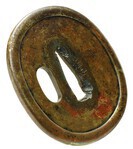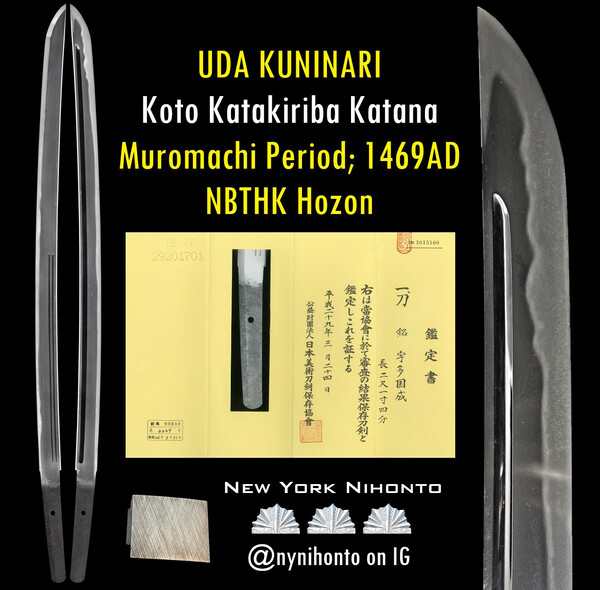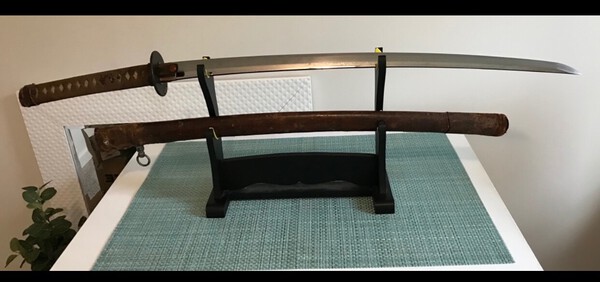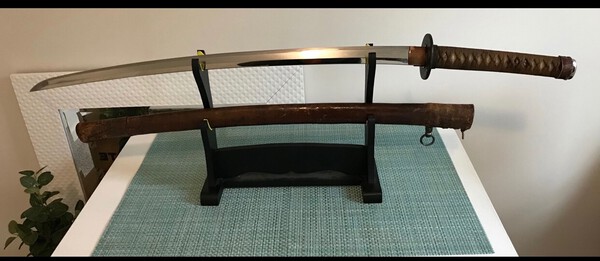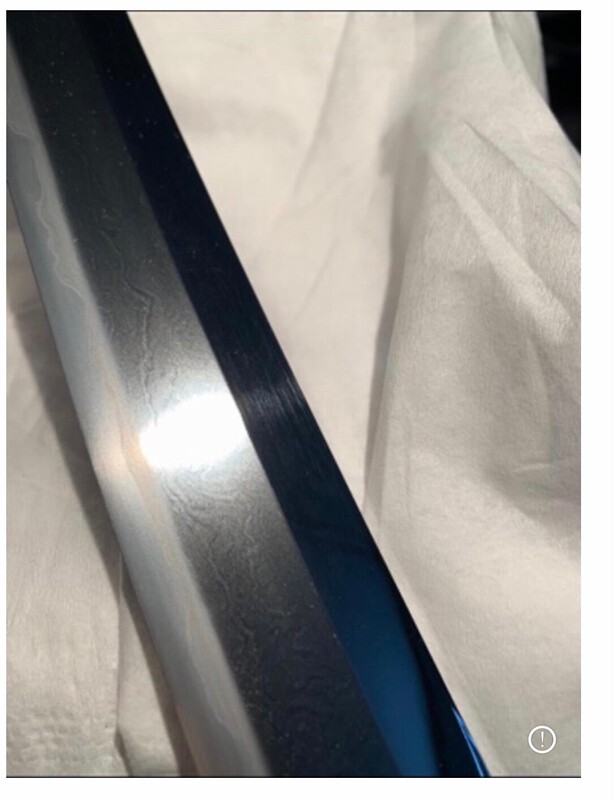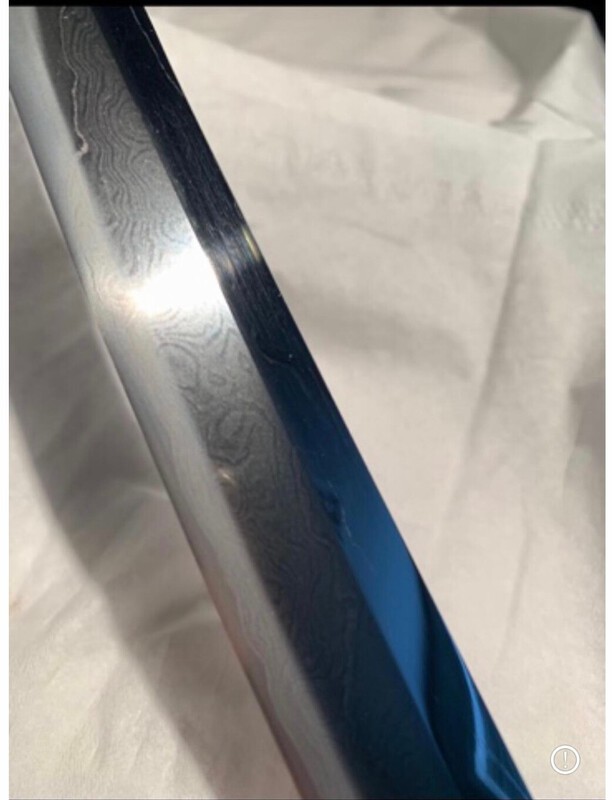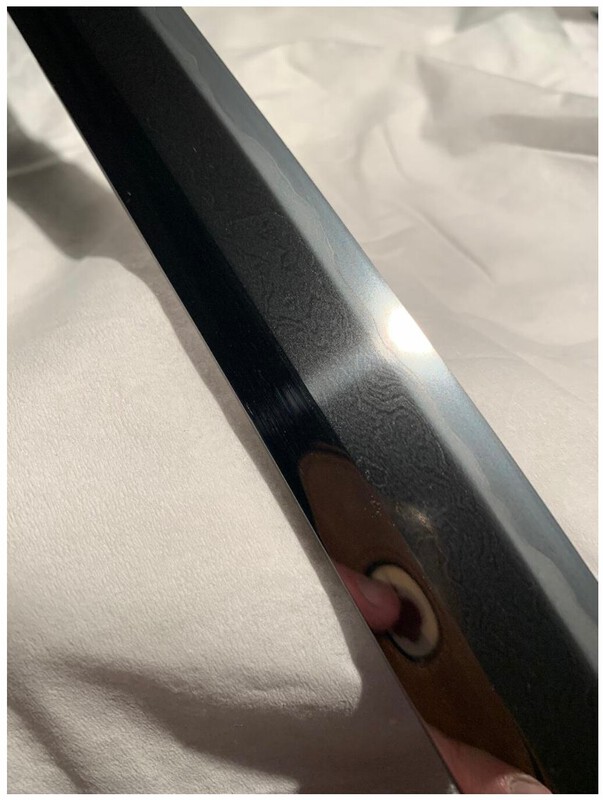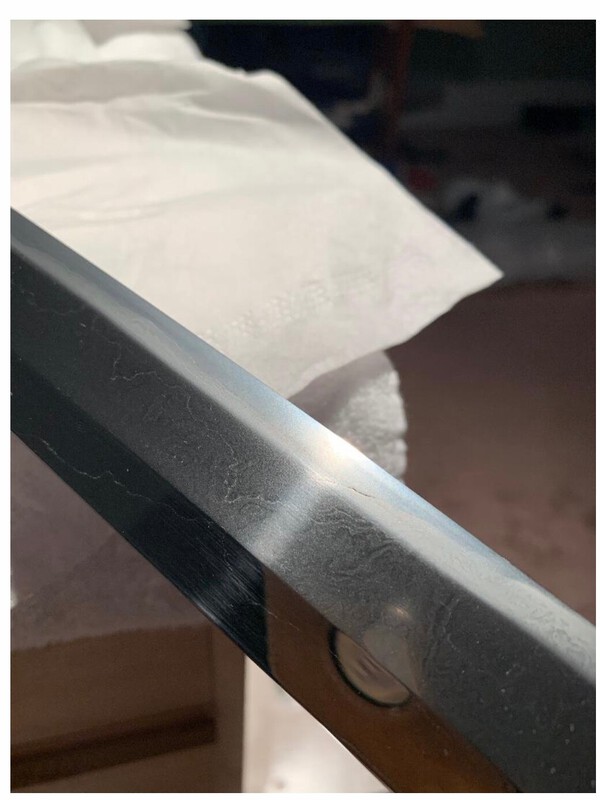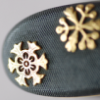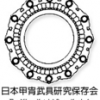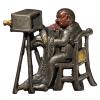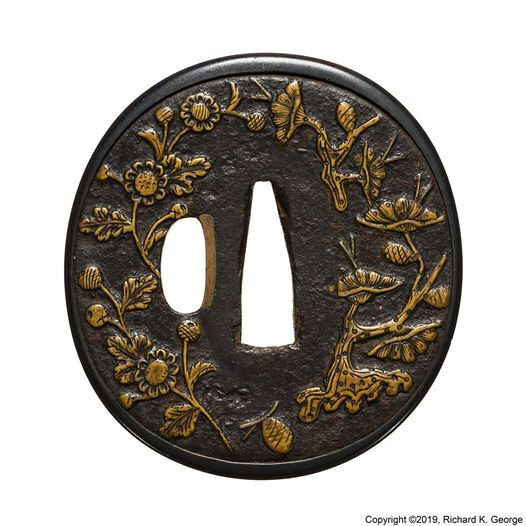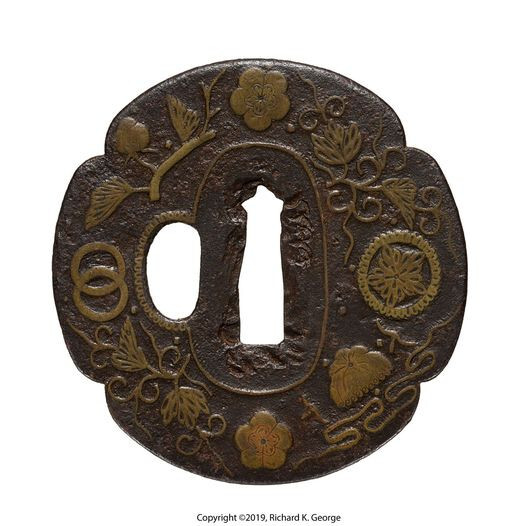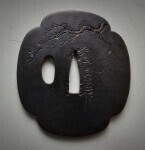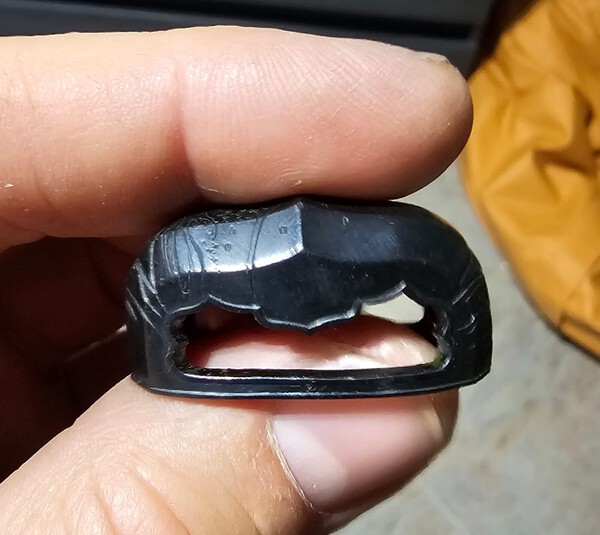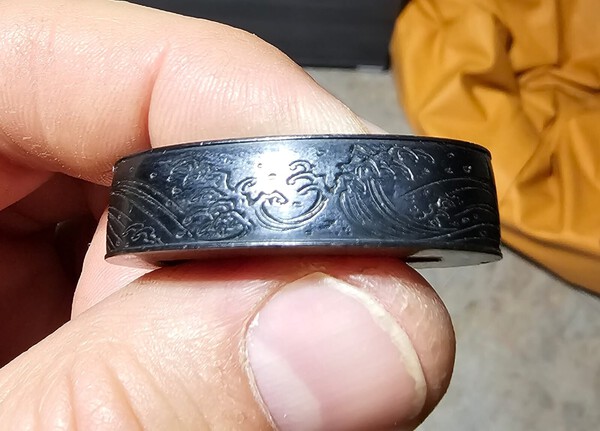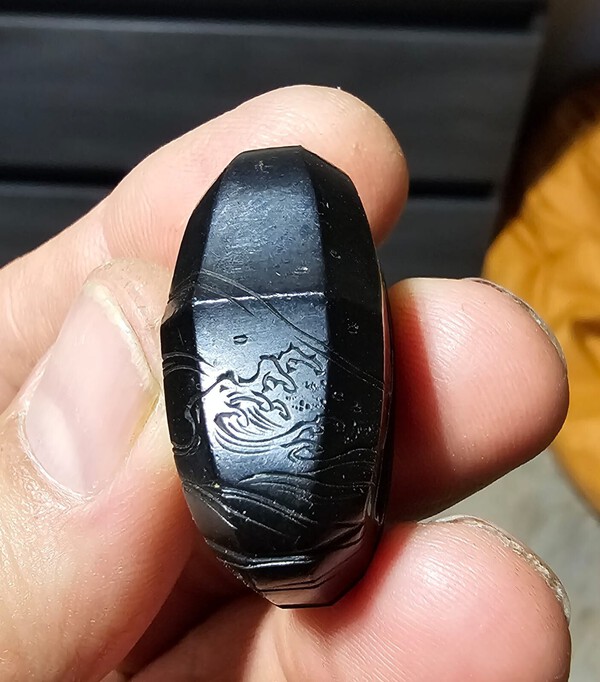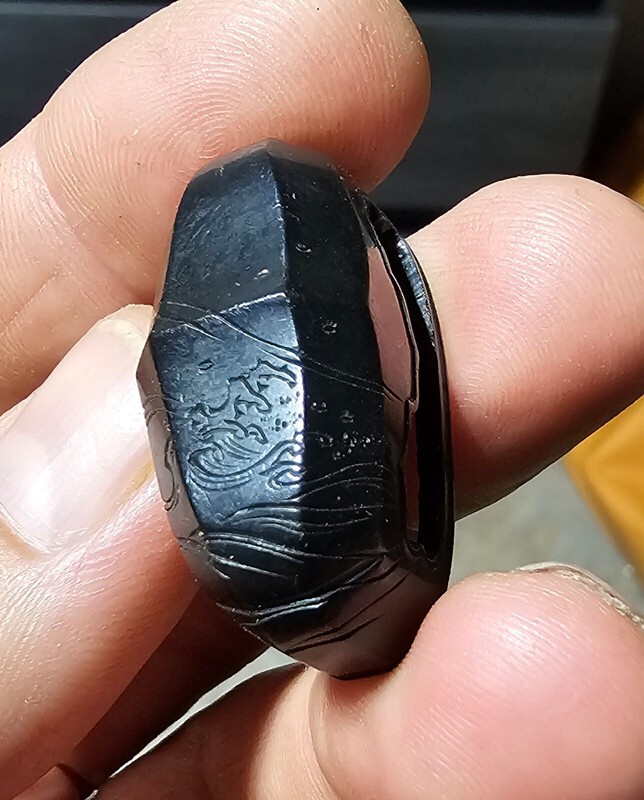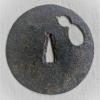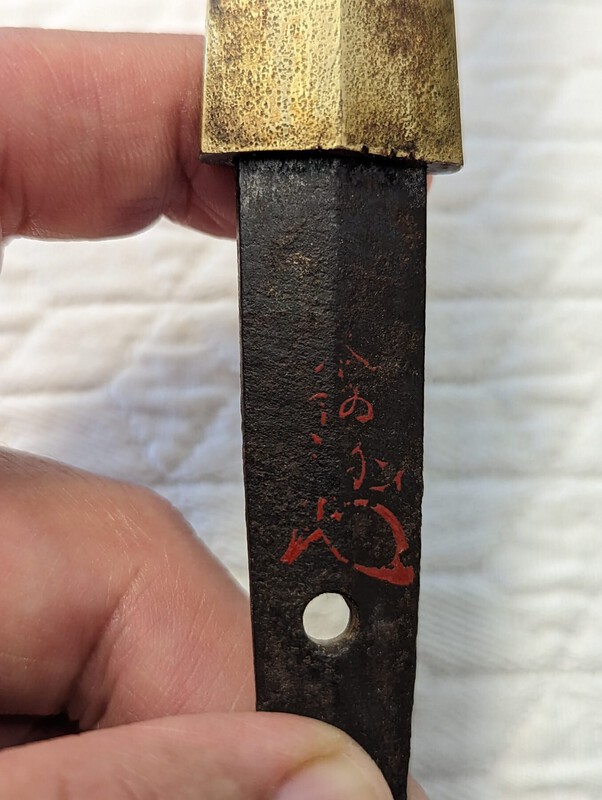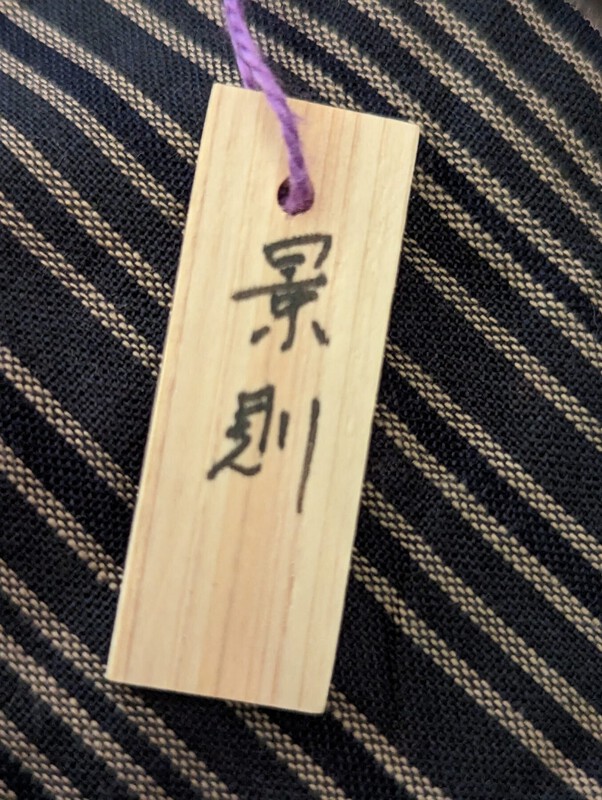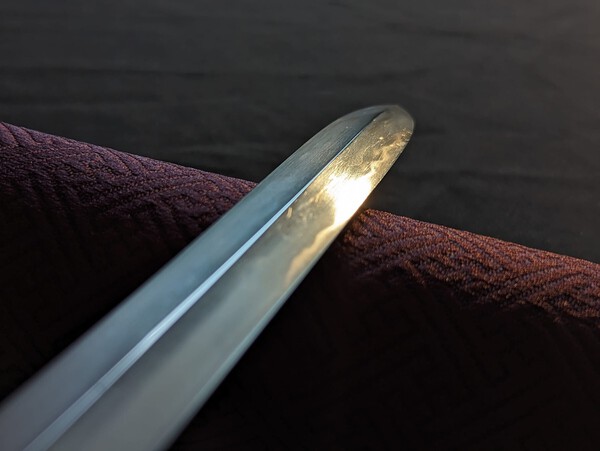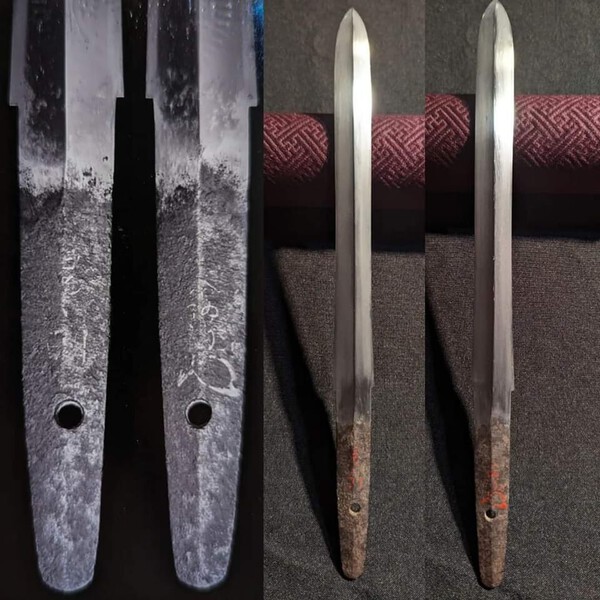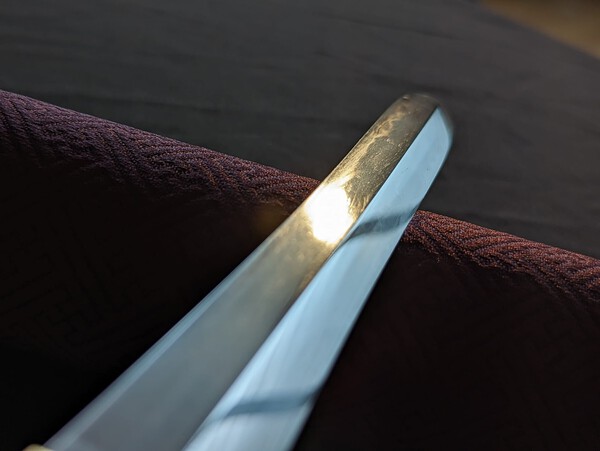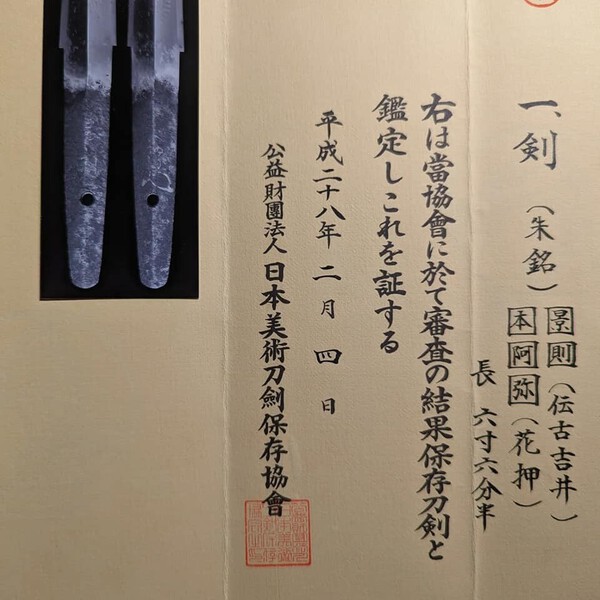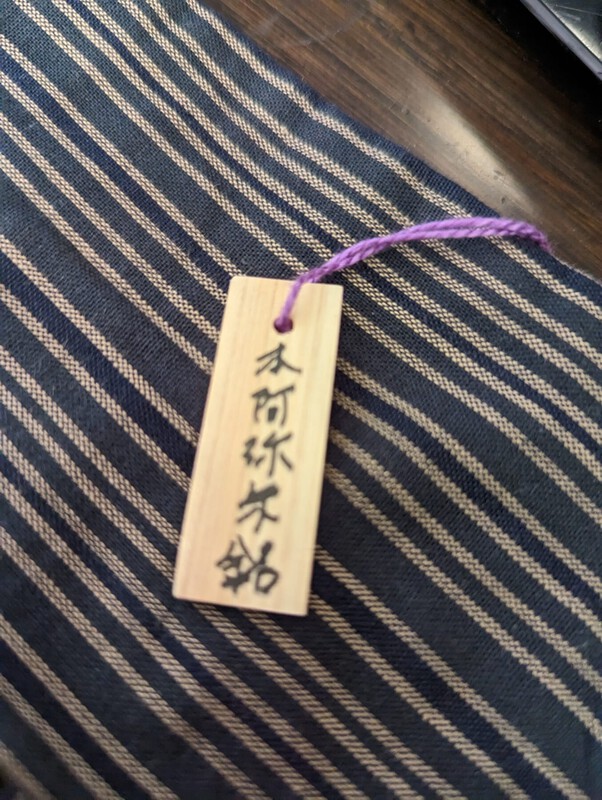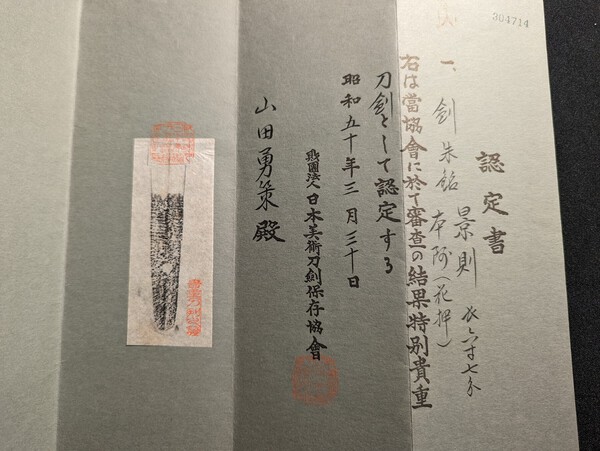Leaderboard
Popular Content
Showing content with the highest reputation on 09/15/2023 in all areas
-
I find this Tsuba very interesting and wondering if any have a Nakago themed Tsuba? I would love to see it. Hope you will enjoy. Details: Iron, octagonal kawarigata shape. The image is of the tangs of swords arranged in pattern around the nakago-ana. The writing is not the artist’s signature, rather the writings are the inscription (mei) found on the tangs of famous Bizen swords: Yasumitsu, Morimitsu, and other inscriptions representing Bizen Osafune and auspicious dates for sword-making. The holes in the top and bottom of the tsuba represent the peg-holes that would be punched into the tangs of swords, but here in this tsuba they possibly also can function as holes used to attach a wrist strap (udenuke-ana). A unique design on a tsuba that is in excellent condition. Video available on website here: https://tsubashi.com...ne-nakago-mei-tsuba/ Mei/signature: Several signatures of Bizen Osafune sword smiths School/province: Unknown Period/age: Edo Measures: 7.60 cm x 7.00 cm x 0.35 cm Certificate: No Included: NO kiri box included13 points
-
I've seen a number of "nakago tsuba" over the years but with the design treatment, folded and layered composition, nagamei + date, etc this is by far the coolest example I've seen.8 points
-
7 points
-
7 points
-
One here I have had on file for years but no information. If you clip off the rim you might get something similar A darker image found on PINTEREST -https://www.pinteres.../474989091940474173/ And another similar - four nakago A page from one of my books showing some very "crowded" versions and a common Chinese forgery.7 points
-
This is, indeed, the family Temple for Masamune and all his lineage since then. This is my family, we have a direct line through the Yamamura family of swordmakers back to Masamune. The photo shows Takeshi Yamamura Swordsmith 24th generation since Masamune. He is the current swordmaker in Kamakura. He showed us all the tombs of the entire family - all marked with the family mon of a round circle with two lines. This depicts the full moon with two strands of cloud. 100% correct information about Masamune at Hongaku-ji Temple, Kamakura.7 points
-
6 points
-
5 points
-
Daniel Bürgin book out.. https://www.amazon.de/Pure-Heart-Naomasa-samurai-century/dp/3757853776/ref=sr_1_1?__mk_de_DE=ÅMÅŽÕÑ&crid=12OX7QVXJGWGQ&keywords=Daniel+Bürgin+with+a+pure+heart&qid=1694747826&sprefix=daniel+bürgin+with+a+pure+heart%2Caps%2C364&sr=8-1&asin=3757853776&revisionId=&format=4&depth=14 points
-
3 points
-
豊後囗囗住国茂作 Bungo something-jū Kunishige saku The middle two might be 鍛治, but I'm not sure.3 points
-
Today I drove down to Kamakura to visit my friend Robert Hughes (well, being one of those jaded, elitist nihontō pricks, I don’t have any real friends, but Bob is the next best thing). After some hearty lunch next to a beautifully maintained Japanese garden we strolled to the Hongakuji Temple (本覚寺) of the Nichiren sect (日蓮宗). Ashikaga Mochiuji (足利持氏) built, and then donated, this temple to the priest Nisshutsu (日出) on the site where Nichiren stayed at after returning from his exile to Sado (佐渡島); the temple houses some of the ashes of Nichiren. A stone monument stands near the main temple in honor of Okazaki Gorō Masamune (岡崎五郎正宗). The story goes that when Okazaki Gorō, still a boy, came to Kamakura, Nichiren had already taken up residence in the Ebisudō (夷堂) Hall. Gorō 's father brought him to Nichiren to learn his teachings, and in return Nichiren gave the boy a new name, Masamune - which implies the rightness of the teachings of Nichiren himself. Nearby is a prayer column dedicated to Masamune, dating from the Muromachi period and finally there are the gravestones of Masamune and his son Sadamune; they date from the Nambokuchō period, and all inscriptions are eroded. To be fair, there are (yet) no hard facts or documents to support all this, only circumstantial evidence. Further research is needed to corroborate all of this. *** See, Bob, you censuring me for taking photos while you explained all this to me was totally uncalled for – I actually *can* multitask! Oh, and if I got something wrong, it’s only because you didn’t explain it correctly.2 points
-
Heard the story when I lived in Kamakura - very happy to know you all have reconnected with your cousins - very happy to see Yamamura Sensei hasn't changed... -tch2 points
-
Something for Christmas tree decoration? Available from the Tokyo National Museum - when? https://www.jauce.com/auction/u10751655552 points
-
Manuel it looks like this one - sorry I have lost the reference to which book the image came from. Your guard [and nice restoration!] is more of a rounded square in shape. You might notice the Chinese copy has used the same pattern as the round one! https://aucview.com/yahoo/m344765922/ https://www.jauce.com/auction/g1088915649 Chinese fake still being sold - https://www.jauce.com/auction/o1057442849 or https://buyee.jp/ite.../auction/o10574428492 points
-
Type: Katana Ubu, Suriage or O-Suriage : Ubu Mei : (Mumei, Signature) : SIGNED - UDA KUNINARI Papered or not and by whom? : NBTHK HOZON Era/Age : 1469AD (MUROMACHI PERIOD) Shirasaya, Koshirae or Bare Blade? : Shirasaya Nagasa/Blade Length : 65.5CM Nagasa, 26” Sori : .5CM Flaws : see pictures Sword Location : USA Will ship to : Anywhere Payment Methods Accepted : Check, Paypall, Bank transfer Price and Currency : 5750 USD Other Info and Full Description : This koto (old sword) katana is in a very rare shape called katakiriba. Most katakiriba swords were made in the shinto period (1596 onward), however this blade was made by an Uda Smith named Kuninari around 1469AD. Kuninari is a very rare smith in the Uda school to find, with Kunimune being the most prolific. Markus Sesko believes this was special-ordered by a wealthy bushi to be used as a side arm were his tachi to have become broken in battle. The mei is well-preserved, and the nakago is ubu with a uniform and rich chocolate patina. The blade is in fantastic condition. The hamon flares out at the end in a Norishige style. Uda smiths worked in a mixture of the Soshu and Yamato traditions. The shirasaya was written by Dr. Kanzan in 1967. “Uda Kuninari, Ubu Nakago, Zaimei, Chinpin Nari.” A well-preserved and fearsome sidearm from the Sengoku Jidai.2 points
-
2 points
-
A generic attribution to Echizen Seki would more likely be a Shinto I think as that was their most active period? On a side note, it's great you're planning to make a koshirae for this but be aware that it will not be financially worth it in the end (it never is, regardless of blade) but in this case may end up costing more than the blade itself it you're going for Edo period fittings and the proper craftsmen2 points
-
I decided on putting this sword up for sale do to financially issues This sword is by far the best and unique hada I have ever seen And in full polish I’m listing it at 4500 only because of the above mentioned You won’t find another like it in this mint condition I like to keep parts original as possible Tsuka Kashera Saya and Tsuba except the retaining strap that I replaced He was a smith in the Meiji era 1868 to 1912 that produced an almost Damascus type of steel in his attempts to emulate the works of Ko Hoki and Etchu Norishige from the Kamakura era. Those works had a notable itame nagare o hada with pronounced chikei. Norishige’s hada is often referred to as “Matsukawa hada” as it resembled the bark of a pine tree. Ikkansai The hamon represents the best of this style by this smith And are very desirable1 point
-
Ben, I love your enthusiasm, and you have the makings of a Nihonto collector. However, I have to say, that you can do better than the pieces you have chosen. You have spent a little over $4000, and for that amount you could get a very nice NBTHK papered (modern accepted version) or NTHK papered blade in full polish, with nice mounts (or very nice mounts if it were a wakizashi). The comments so far have been very respectful, and reflect the fact that most of us made questionable choices early in our collecting career. I have put my honest opinions about the four blades you have bought below, trying to be kind and helpful, but have also added some suggestions for your future plans in collecting. 1. This looks like a genuine Japanese samurai sword in edo mounts. Probably early shinto or perhaps late muromachi, and Bizen Sukemitsu (as it was listed) isn't a bad guess, though whether the signature is "good" is not known without papers. You didn't pay too much for it, but you ended up with a sword that is not in particularly good polish that is not worthy of the expense of a polish and appraisal for papers (my opinion). My advice is to study it, learn about the five schools and where Bizen fits into the early sword making, enjoy it for a while and move it along. A general comment that I hope you take to heart is that it is important to test your ability to sell a Japanese sword. They are easy to buy, hard to sell. If you take good photos, or recycle the ones from the listing, you should be able to sell this one on ebay for about what you paid for it. 2. This is signed Bizen but is not in very good polish. As you can see, it has many ware (pronounced wah re, Japanese for forging flaws), along both sides. Because of the ware, it is also not worthy of polish or papers. It's very hard to find treasures on ebay in general, but particularly on items coming directly from Japan. Again, my advise is to enjoy it as long as you can and then move it along. 3. You know it and you said it. This one is junk and probably not genuine. When you see the kissaki having no curve in it (just the tip looks like a triangle), that is usually a dead giveaway of a fake. Sell it right away or use it to cut weeds in your garden. It is a 100 bucks well spent if it teaches you to control your reflexes in the future and don't bid on such things. Although it was many decades ago, I too went through a phase where I bought my share of basket cases... 4. This is a shobu zukuri wakizashi - possibly a cut down naginata. It has the old papers attributing it to Kanebo Masatsugu (a Yamato smith). As you know, these old papers from the 1970s are disregarded. However, since it is mumei, it doesn't really much matter, since it doesn't have a fake signature on it. It is probably late koto, the Yamato school is possible, and is in decent polish. You bought it from Showa22, who, along with Komonjo, should probably be viewed as a US dealer selling stock that comes straight out of Japan. The price wasn't bad. Again, my advice is enjoy it, study it, but don't bother to get modern papers or do anything else with it. Then move it along. The last one is a Chinese fake, please don't buy it. You have received good advice so far in this thread. Buy books and read them! Become an avid student of NMB. Go to shows and meet people - there are lots of friendly collectors that are happy to help a new collector. Don't get depressed about these early purchases, most of them sold for what they are worth. Just learn how to sell them. If you can't get your money back out of them, you may have overpaid or have to refine your sales technique. As your taste matures, you will hopefully look for two types of blades. First, ones that have no issues and need no restoration - are in good polish, have papers, have nice mounts if that is what you like, etc. This is the best way to build a fine collection these days. Since you and your wife go to Japan, you might do some shopping at sword shops (probably best to avoid those in the Ginza and super high priced establishments elsewhere). You can comparison shop though. Set a budget, ask to see what they have, and by the time you have visited four or five stores, you will know what you can buy for your budget. The dollar is very strong now and you may be quite surprised. Also, if you look on the NMB "for sale" section, you can find some very nice blades in excellent condition with papers and mounts. Second, eventually, you can try to find ones that are candidates for restoration. Twenty five years ago, this was easier on ebay, as there were many GI families selling their father or grandfather's sword on ebay and it was possible to find good signed shinto or shinshinto blades, and good mumei or signed koto blades, that needed restoration. It is a thrill to find a neglected blade that has been sitting for 70 years in an attic or garage that is worthy of restoration. Even then, to do it right, one needed a good reference library to make your own estimate as to whether any signature the sword had was genuine or not. These days, the frequency with which these candidate blades come up on ebay is dramatically low. One can still find them at Japanese sword shows such as in Florida, Chicago, San Francisco, Vegas (your home!) etc. This second approach takes more study than the first approach and I recommend that you focus your next purchases on category 1. Even buying fully restored and papered blades is best done after significant education. Most of us build our collection from the top. To do that one should be in search of better and better pieces and only buy ones that are better than the average or the top of ones collection. When you buy one, sell the ones at the bottom of the collection to get the funds for the next purchase. And finally, enjoy these amazing, historically important objects!1 point
-
Sendai men: I think he ment the Tohoku or Kanto, short east Japan style of menpo. This one could more or less fit in this group.1 point
-
Hi Adam, The Shinto Era call sounds good to me. Echizen Seki School with very active in the Shinto Era with many different swordsmiths. Yes, assembling a koshirae is a very money losing process. It can be rewarding if in the end you get something that you like and plan to keep for an extraordinarily long time in your personal collection. You should be aware that all dealers from the USA to Japan and all place in-between (i.e. Poland) will generally break down all assembled koshirae for share parts or sell parts individually that are of decent quality. I learned that the hard way while trying to have a Japanese art business in the USA that had a fair number of Japanese swords. Thankfully, the business is closed, and my conscious is clear.1 point
-
Like Ray I've seen many examples of the more usual nakago in a circle arrangement over the years, but this squarish form is really an excellent interpretation of the concept. I particularly appreciate the irregularly shape nakago ana, elegant and subtle touch. The big problem with nakago tsuba, of course, it that I cant see the point , I'll get my coat.1 point
-
Jo Are you part of the branch of the family established after the Great British Exhibition? -t1 point
-
1 point
-
It was a joy to re-read this thread. Brian, how about a 'sticky' "In memory of a celebration" - or should that be "cerebration"!! BaZZa.1 point
-
Hi, I have a Daisho by Kozuke Daijo Sukesada. Type Kazuke Daijo Sukesada Daisho into the NMB Search and a few photo's will turn up. How much are you willing to spend? David Flynn posted a topic in Nihonto A friend asked me to take some photo's of my Daisho for him, so why not also share here.1 point
-
Dale, That modification is not ideal, but it is what it is. The Japanese seemed to be pretty pragmatic about modifying kodogu to suit whatever their current need happened to be. Changing the shape like that is more extreme than say punching kozuka/kogai ana into pieces that didn't originally have them, but pieces with added hitsu are generally still considered to have value (though not as much as an equivalent piece that didn't have added hitsu). Sometimes buying modified pieces are the only way somebody on a budget can own an example w/o it being a complete wreck. I've had a couple of Ounin tsuba that were modified - one was reduced in diameter (which I won't post an image of out of deference to the new owner), and this one was made into a mokko shape: and here's an old heianjou where the owner modified the shape by adding an oval fukurin mimi in addition to the diameter probably having been reduced some (as well as having the more typical modification of an added kozuka hitsu): And I was just going to get back to work on editing a description of a Juyo kogai naoshi, so clearly the powers that be believe some modified pieces do have historic value... Best, rkg (Richard George)1 point
-
Thanks Matt. I would also lean towards early Edo and Shinto (or at least I hope for it). I fully agree about Koshirae costs. Simple example, below Fuchi and Kashira costed me already 250$ and that's just a start of completing the set. However, for me personally, nice Koshirae matters a lot. I'm willing to pay for it and I'm aware that I probably won't get my money back if I want to sell the sword in future (although not planning to).1 point
-
1 point
-
1 point
-
This is just my opinion but 7M yen is greatly overpriced. I believe USD vs. Yen has shifted a lot from spring as this was listed in April for 64k USD. https://web.archive....o-token-certificate/ Here are some comparison items for viewing. Unshō katana (mumei) - c. 2,7M yen Jūyō 55 - https://www.aoijapan...thk-55th-juyo-paper/ Unji tachi signed & dated 1327 - c.7M yen Tokubetsu Hozon (this item is absolutely wonderful historically) it seems to have sold lately, one of the most interesting blades of this school I've seen being sold online - https://eirakudo.sho...katana/detail/768547 Unji tachi (mumei) - c.2M yen Tokubetsu Hozon - https://web.archive....cn11/cn22/pg544.html Unji tachi signed - c.2,5M yen Tokubetsu Hozon - dealer didn't sell this at auction but it was gone from their website fast where it was listed for price mentioned here: https://buyee.jp/ite.../auction/q1098056239 Unji tachi (mumei) - c.2,5M yen Jūyō 49 (koshirae) - https://www.aoijapan...th-nbthk-juyo-paper/ Unji katana (mumei) - c.8-10M yen Tokubetsu Jūyō 6 - Qualitywise probably among the best Unji that have been online sales, this has been through multiple dealers: https://www.samurai-...net/SHOP/V-1800.html Unji katana (mumei) - c.4,5M yen Jūyō 53 (koshirae) - https://www.seiyudo.com/ka-020321.htm Unji katana (mumei) - c.2,8M yen Jūyō 22 - Kirill linked this one earlier https://web.archive....the-22nd-juyo-token/ Unji katana (mumei) - c.2,7M yen Jūyō 21 (koshirae) - https://www.aoijapan...th-nbthk-juyo-paper/ Unji katana (mumei) - c.2,7M yen Jūyō 17 (koshirae) - https://www.aoijapan...th-nbthk-juyo-paper/ Unji katana (mumei) - c.3,5M yen Jūyō 13 - https://eirakudo.sho...katana/detail/224967 Unjū katana (mumei) - c.1,5M yen Tokubetsu Hozon - https://eirakudo.sho...katana/detail/213458 Unjū katana (mumei) - c.4,5M yen Jūyō 65 - https://katananokura.jp/SHOP/2104-K01.html Unjū katana (mumei) - c.2,5M yen Jūyō 62 - https://web.archive.org/web/20220930200639/https://www.touken-sakata.com/刀剣一覧/刀-無銘-雲重-古刀-上作-良業物/ Unjū katana (mumei) - c.2,9M yen Jūyō 48 - https://www.aoijapan...attributed-as-ynjyu/ Unjū katana (mumei) - c.2,5M yen Jūyō 27 - https://www.aoijapan...th-nbthk-juyo-paper/ Unjū naginata-naoshi (mumei) - c.2,5M yen Jūyō 27 - https://web.archive....0/SHOP/1203-K11.html1 point
-
I think items like this fall into extremely rare curiosity category. I used my tracking skills and it seems like Samurai Museum had it listed for 9,126$ in december 2022. They are actually often having quite large profit margin added on items that have been at Yahoo JP and then came to their site, so I would assume they have large profit margin on every item. To me it seems their site is geared towards international buyers. Of course it is business and they have to make a profit. However just wanted to mention this if a sword is acquired from dealer who already has large margin in original price and new dealer adds on his/hers margin, then the item can get bit inflated. Yet in the end items are worth what someone is willing to spend for it, and there are different valuations depending on what people focus on.1 point
-
Kamakura period ken with current NBTHK papers to Kagenori, who is from the Fukuoka Ichimonji lineage and also a member of the early Bizen Ko-Yoshii school. Early ken of this age are exceptionally rare, and this one is ubu. There is a Hon'ami shumei indicating the Kagenori attribution (upheld by two sets of papers). The ken has a small choji hamon, like Ichimonji in miniature. A very beautiful and uncommon piece to encounter. Nagasa: 20cm (6 sun 6 bu) Price: $6,500 (plus shipping) Best regards, Ray1 point
-
Hi Tom.... Thanks for bringing this to the attention of others ...... I didn't want to post it myself.....in the budo spirit of humility..... even though it would serve as powerful advertising... Many, many hours go into the preparatory and planning stages....then a day in on-site planning for story continuity... and then the big day filming which lasted from 9:00 a.m. until 4:00 p.m. There were many retakes due to outside noise interference of general traffic and tourism in Kamakura. Actually, we shot around two hours of content that was whittled down to fifteen minutes. Lots of historical overview and some mistakes were edited out......and most of my humorous quips got a quick cutting test....... The final stage is the tedious editing done professionally by a talented professional in Kamakura, Mr. Oe who deserves credit for both his camera work and his editing skill. I hope NMB folks enjoy this.... It took a lot of work.... Can we move it so it starts an original thread as the Soshu tradition it might get overlooked attached to the bottom of Guido's ego....I mean thread....? Best, Robert1 point
-
Greetings thread followers...especially former Kamakura resident, Big Bad Tombo! So first off....Tom know his Japanese history and his Kamakura s**t! However, there seems to be an evolution in thought among Hongakuji administrators. This is the part that needs further research as pointed out by Guido...... So Tom, when flights and immigration matters get smooth I invite you to help me resolve the budding contradictions at Hongakuji.... Within the grounds of Hongaku-ji, there is a tall stone monument that was set up in the late Edo period, Tempo 1835. Inscribed: Myoho Goro Nyudo Masamune hi Tempo kinoto hitsujidoshi aki Kankarin shujin sho which translates into Lotus Sutra Monument of Goro Nyudo Masamune Fall in the year of the sheep Tempo (1835) by the donor Kankarin, a pseudonym of Matsudaira Naooki, a Mori fief Daimyo. On the backside is a reference stating that Masamune was ordained to priesthood by Nichiren, hence the "Nyudo" addition to the name. So we can say the Nichiren/Masamune connection is “carved in stone.” Inscribed in the base are the names of sword dealers who also contributed to this memorial. Moving into the cemetery about 15 meters from the tall momument, we find a stupa said to have been erected by an early generation Yamamura Tsunahiro to mourn his ancestor Masamune. The stupa pedestal inscription reads: Shinryu-haka tsuchinoe-ne shogatsu juichinichi zokumyo Masamune: translated as Grave of Shinryu, eleventh day of the first month of the of the earth rat which could correspond to 1348. Masamune’s posthumous Buddhist name is Shinryu Nikken. Taking into account the timeline between the death of Masamune and the working period of Yamamura Tsunahiro, there is quite a gap in time. Therefore it is illogical to conclude that this marker actually is Masamune's grave, unless it was erected over top of Masamune's original resting spot.... so where does Masamune actually rest? The big mystery..... Deeper in the cemetery grounds, there are two very ancient tomb markers, in very early form (Nambokucho style) with inscriptions weathered away. A month ago, when I visited Hongakuji, I went to the admin. office and made an inquiry to end this dilemma. Not being able to resolve this neatly was causing me stress and serious sleep loss. This may well account for my obesity......not knowing the truth: overeating and drinking for the past forty years. I am blaming my poor physical condition .... you guessed it.....on Guido...not Masamune. Guido makes me drink too much, but not for long as Guido will be moving back to Germany in July. Sorry for the digression..... A kind Hongakuji Temple administrative attendant explicitly stated that these two ancient tombs were those of Masamune and Sadamune, side by side resting for eternity. Next to these two tomb markers, is a large Yamamura family tomb and nearby are a series of at least ten individual markers for the remains of successive generations of Tsunahiro swordsmiths. As Tom has mentioned the current Yamamura Tsunahiro is the 24th generation successor.....so you see the Soshu school lives on in Kamakura. So friends, the truth hinges on whether the Temple administrator was pulling my leg or not..... Next time I will ask for supporting documentation..... Yours in serious investigative journalism, RRH1 point
-
What a great afternoon! I spent many a day here when I lived in Kamakura - actually the Kamakura Branch of the NBTHK holds their monthly meetings at this very temple, so we were literally studying at the foot of the great master. I would like to make some small additions to the information. The large stone that Guido is standing in front of is from the Edo period - it was dedicated by a collection of sword dealers, who owed their prosperity to his excellence (Masamune not Guido). If you were to look closely at the square stone at waist height on Guido, the names of all those who donated to have the stone erected are inscribed there but the years have nearly worn them away. The grave where Bob is standing is the grave of Masamune. As Guido pointed out Masamune can also be read Seiso and means "true teaching" however he got the name he was a devotee of the true teaching of Nichiren. The very ancient pair of graves in the last photos are held to be the family graves of the Yamamura Family, so may include Sadamune and other early members of the school (family). Incidentally Yamamura Sensei still practices sword craft in Kamakura as the 24th generation Masamune, Yamamura Tsunahiro. Kamakura is absolutely the place to visit for anyone interested in the sword, Bob is very lucky to make his home there taxes or no... -t1 point
-
Amazing.....Guido was paying attention to my long-winded explanations! We had wonderful weather for our little walking tour. It is enjoyable days like today that remind me why I chose to live here.... The euphoria lasted until I got home and opened the Bill for property taxes which comes every three months like clockwork.... Yes, the fifty-four temples and shrines that attract visitors....like Guido.... are all tax exempt! I think I will have to declare myself high priest and Guido as my first disciple....all our religious observances will involve rituals with lager, raw oysters, and possibly bratwurst...to keep Guido’s spiritual motivation high.... and get tax exemption! Stay tuned ....a detailed video production will be out soon with more detail regarding Masamune and Shizu Saburo Kaneuji.....1 point
This leaderboard is set to Johannesburg/GMT+02:00



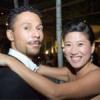


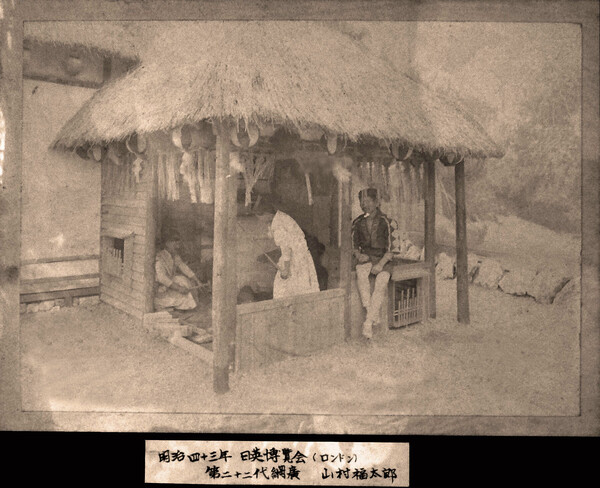
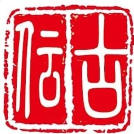
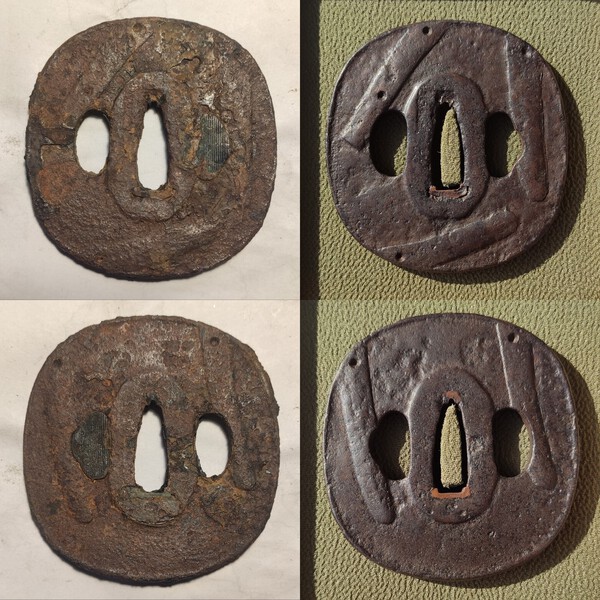


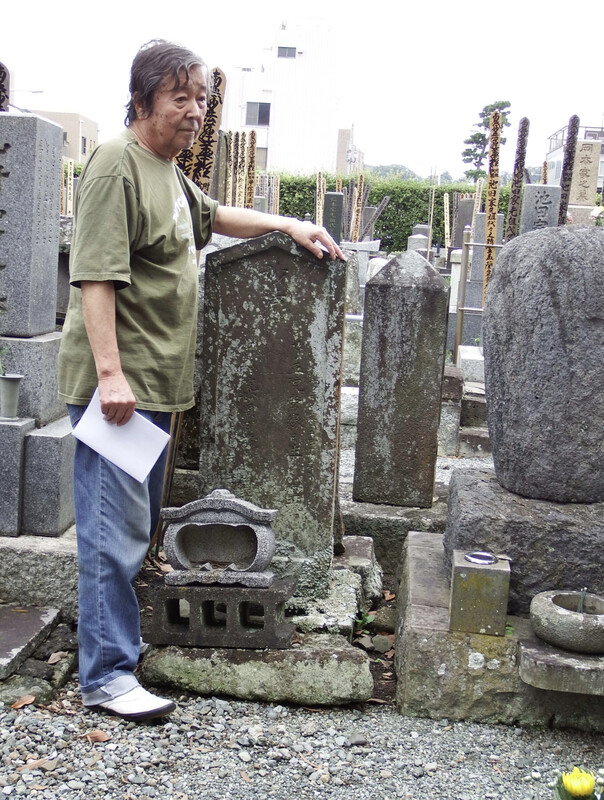
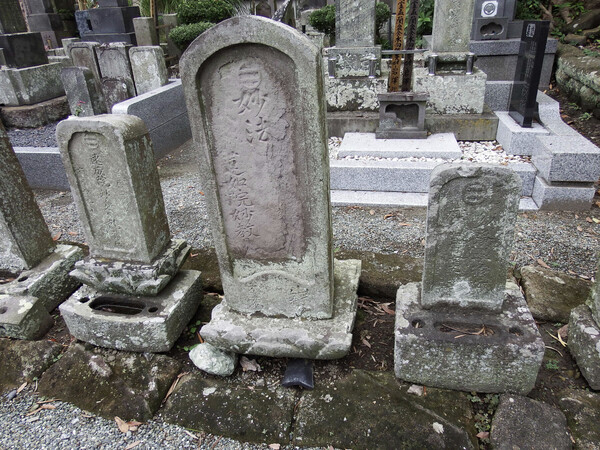





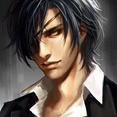

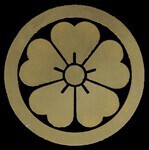
.thumb.jpg.16bf5cc360347306b620b1ae94acfc90.jpg)
.thumb.jpg.882e2ac86c347d73c8b06703fa90a03e.jpg)
.thumb.jpg.29fc3589e7bd887201502ddc0fa88666.jpg)
.thumb.jpg.f7ab98e8d0192625a6c844fbb6e399cf.jpg)
.thumb.jpg.b6c0098032580658ac47fe25205218a6.jpg)
.thumb.jpg.cc44b7ead20cba3b55e8d848183d8924.jpg)
.thumb.jpg.512ab6dc61670f32700697919079c575.jpg)
